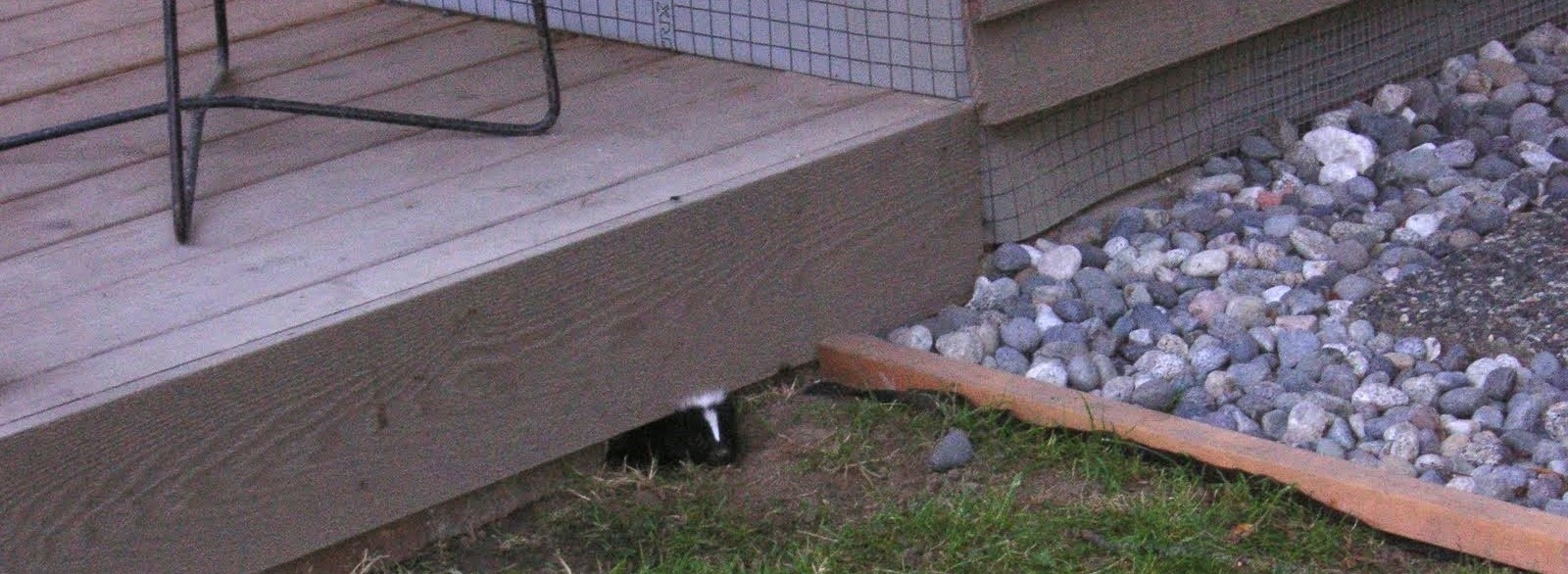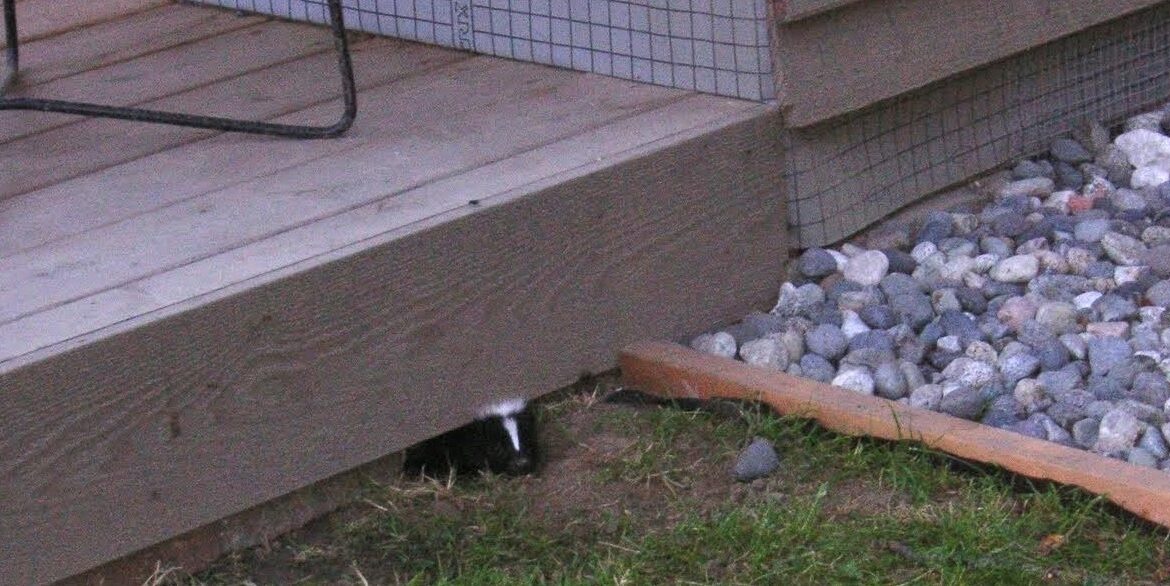You hear rustling sounds under your porch at night. A strong smell drifts through your yard. Your dog refuses to go near that corner of your property. These signs might mean skunks have moved in, and if it’s the right time of year, they could be getting ready to have babies right under your home.
Skunk birthing season happens at a specific time each year. If you’re wondering when skunks have babies, the answer is usually between late April and early June. This timing means pregnant females look for safe, quiet places to give birth in early spring. Your porch, deck, or shed might seem perfect to them.
Skunks under porches are common because these spaces offer protection from predators and weather during their most vulnerable time.
Let’s explore everything you need to know about when skunks have babies and what it means for your property.
You’ll learn the signs that indicate skunks might be preparing for birth under your porch, what happens during skunk birthing season, and when to call professionals like Skedaddle Humane Wildlife Control in Montreal.
The Skunk Birthing Timeline
Skunks follow a predictable schedule when it comes to having babies. Understanding this timeline helps you spot potential problems before they get worse.
- Mating Season (February to March): These animals mate during late winter when snow still covers the ground. Male skunks become more active and travel farther to find females. You might notice more skunk activity or smell them more often during this time.
- Pregnancy Period (April to May): After mating, female skunks are pregnant for about 60 to 77 days. During pregnancy, they start looking for the perfect spot to have their babies. This is when they often move under porches, decks, sheds, and other protected areas around homes.
- Birth and Early Life (May to June): Baby skunks, called kits, are born in late spring. A typical litter has 2 to 10 babies, but 4 to 6 is most common. The babies are born blind, deaf, and helpless. They depend completely on their mother for the first several weeks of life.
- Growing Up (June to August): Young skunks start opening their eyes at about 3 weeks old. They begin walking around 6 to 8 weeks. By late summer, they’re ready to leave their mother and find their own territories.
Why Skunks Choose Your Porch
Your property offers many attractive features to pregnant skunks. Understanding why they pick certain spots helps explain why you might find them under your porch.
Safety and Protection
They need safe places to raise their young. Porches, decks, and sheds provide excellent shelter from:
- Rain and snow
- Wind and extreme temperatures
- Predators like coyotes, foxes, and birds of prey
- Human disturbance
Easy Access
Skunks are good diggers, but they prefer easy entry points. Small gaps under porches or decks make perfect doorways. They can squeeze through surprisingly small spaces – any opening larger than 4 inches gives them access.
Food Sources Nearby
Skunks are opportunistic eaters. Your yard probably offers plenty of food options:
- Insects living in your garden
- Fallen fruit from trees
- Pet food left outside
- Garbage that’s easy to access
- Grubs and worms in your lawn
Signs Skunks Are Preparing for Birth Under Your Porch
You don’t always see skunks directly, but they leave clear signs of their presence. Recognizing these early warning signals helps you act before babies arrive.
- Smell: One of the easiest ways to know if skunks are nearby is by their strong, unmistakable odour. You might notice the smell in the evening when they are most active or after rainstorms, as moisture can make the scent stronger. Pay attention to areas near entry points under your porch or deck, especially if your pets seem to avoid those spots.
- Sounds: Skunks can be noisy, especially at night. Listen for scratching or digging sounds coming from under your porch. You might also hear rustling in leaves or debris, light thumping as they move around, or even chittering and chattering noises. These sounds are often a clear sign that skunks are making themselves at home.
- Visual Evidence: If you suspect skunks, look for physical signs around your property. Small holes or disturbed soil under structures are common indicators. Torn insulation or other nesting materials might also be visible. Check for paw prints in soft soil—skunks have five toes with long claws. Droppings that resemble cat waste but may contain insect parts are another clue.
- Disturbed Areas: Skunks are known for creating cozy nesting spots. They often move leaves, grass, and debris into piles to make their den more comfortable. You might find shallow depressions dug into soft soil or insulation pulled into their hiding spots. They also create clear pathways between their den and food sources, which can be another sign of their presence.
What Happens During Skunk Birthing Season
Once baby skunks arrive, the situation under your porch changes dramatically. Understanding what happens helps you prepare for the months ahead.
The First Few Weeks
Newborn skunks are incredibly vulnerable. They can’t see, hear, or walk. The mother rarely leaves except to find food and water. During this time:
- You might hear soft chirping sounds from babies
- The smell becomes stronger as more animals use the space
- The mother becomes very protective and more likely to spray if threatened
- Activity increases as the mother makes multiple trips for food
Growing Independence
As babies grow, they become more active and curious:
- Young skunks start exploring near the den entrance
- You might see small skunks playing or wrestling
- They begin following their mother on short trips
- Noise levels increase as active babies move around more
Preparing to Leave
By late summer, young skunks are almost ready to live on their own:
- The family makes longer trips together
- Young skunks practice foraging skills
- They start spending nights away from the den
- The mother begins encouraging them to find their own territories
The Problem with Waiting
Many homeowners hope skunks will leave on their own. While this eventually happens, waiting creates several problems you should consider.
- Property Damage: They can cause a surprising amount of damage while living under your porch. Their digging can weaken foundations and walkways, creating costly repairs. Torn insulation is another issue, as it reduces your home’s energy efficiency. Urine and droppings left behind create unsanitary conditions, and multiple entry points made by skunks can weaken the structural supports of your home.
- Health Concerns: Skunks can carry diseases that pose risks to both humans and pets. While rabies in skunks is rare, it’s still a concern. Parasites like fleas, ticks, and mites can spread to your pets, causing discomfort and health issues. Bacterial infections from skunk droppings can contaminate the soil, and their strong odours may trigger breathing problems in people who are sensitive to smells.
- Attracting More Wildlife: A single skunk family can lead to even bigger problems. Other skunks may move into nearby areas, and animals like raccoons and opossums might also find your property appealing. This increased competition for food can lead to more conflicts, and having multiple animals around often results in more damage and larger messes to deal with.
Professional Wildlife Control Solutions
When skunks are raising babies on your property, it’s important to get professional help. At Skedaddle Humane Wildlife Control, we use safe and proven methods to solve the problem and prevent it from happening again.
One of our best tools is the one-way door system. This device allows skunks to leave their den but stops them from coming back inside. It’s a safe and stress-free solution for both the skunks and your family, with no harmful chemicals or traps involved.
Our team starts with a full inspection of your property. We check for all the spots skunks might use to get in or out and look for areas that could attract wildlife, like open garbage or pet food. After the inspection, we place one-way doors at the main entry points and seal up other holes to keep animals out.
If needed, we add barriers like wire mesh to stop skunks from digging back in. We can also suggest changes to your yard, like keeping grass short or removing wood piles, to make your property less inviting to wildlife.
Time to Take Action
Skunk birthing season brings unique challenges that require professional attention. If you suspect skunks under your porch are preparing for babies, acting quickly prevents bigger problems later. The longer you wait, the more damage occurs and the harder removal becomes.
Skunks under porches during birthing season create health risks, property damage, and ongoing conflicts with pets and family members. When they have babies, they become more protective and territorial, making professional intervention essential for safe resolution.
Skedaddle Humane Wildlife Control in Montreal understands the complexities of skunk birthing season. Our team uses proven methods that protect both your family and the animals while solving the problem permanently.
Don’t let skunks turn your porch into their nursery – contact us today to request an estimate and learn how we can help restore peace to your property.




